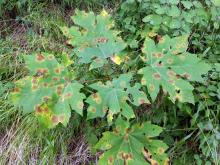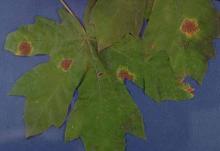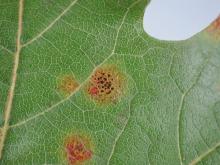Cause Rhytisma punctatum, a fungus. The disease is common on bigleaf maple on the Pacific Coast and also attacks many other species, particularly silver, mountain, and striped maple. The fungus overwinters in stroma on fallen leaves. Leaf areas with stroma do not decompose as fast as areas that are not infected. Infection occurs as spores are ejected from these overwintered leaves during rainy periods in the spring.
Symptoms When first invaded, leaves develop minute (1 mm diameter), water-soaked spots that turn brown. Soon small, dark dots appear on the upper leaf surface between the veins. The black, tar-like spots (stroma) are slightly raised above the leaf surface. The lower leaf surface is yellow under the tarspot. Leaves may fall prematurely if infection is severe. A green island effect may occur when the entire leaf turns brown.
Cultural control
- Rake and burn fallen leaves.
Chemical control Spray when leaf buds are opening and twice more at 10-day intervals if the season is wet.
- Bordeaux 8-8-100. Group M1 fungicide. O
- C-O-C-S WDG at 3.9 lb/A plus 2 lb hydrated lime/100 gal water. Group M1 fungicide. 48-hr reentry.
- Mancozeb-based products. Group M3 fungicides. 24-hr reentry.
- Fore 80 WP at 1.5 lb/100 gal water plus a spreader-sticker.
- Protect DF at 1 to 2 lb/100 gal water plus 2 to 4 oz spreader-sticker.
Reference LeRoy, C.J., Fischer, D.G., Halstead, K., Pryor, M., Bailey, J.K., and Schweitzer, J.A. 2011. A fungal endophyte slows litter decomposition in streams. Freshwater Biology 56:1426-1433.





